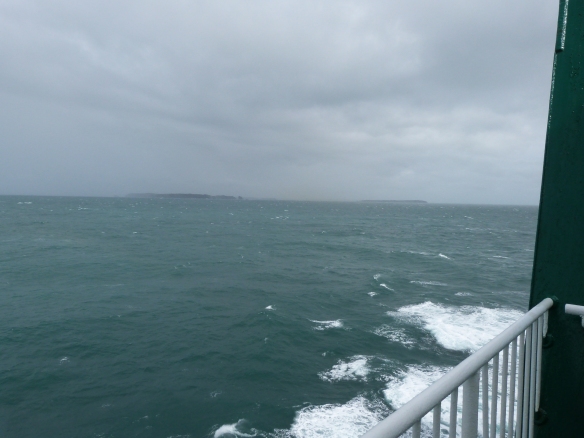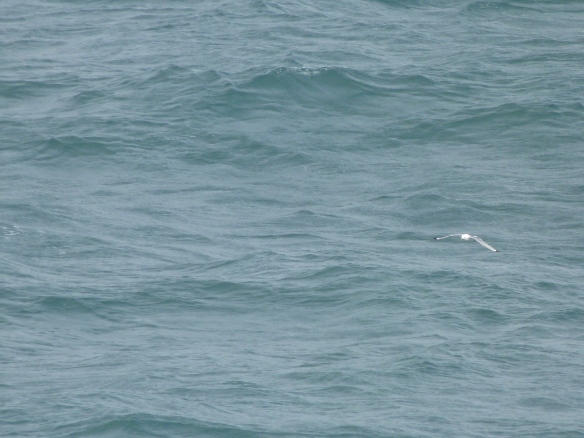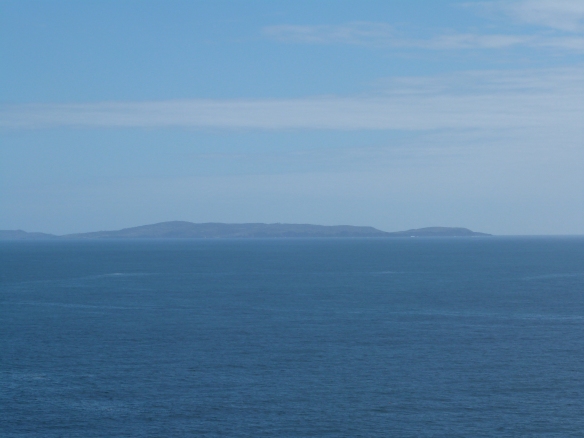In 1830’s America it was considered Manifest Destiny for east coast residents to head west in search of a new life and a chance to stake a claim to their own piece of the new frontier. There was one decision to make, Oregon or California as your final destination. Most of these journeys were undertaken in a rickety old wagon, many failed through lack of planning, money or ability to take the correct provisions (there are many tales of people some considerable distance along the trail jettisoning their writing tables and desks, considering them surplus to requirements – space that could have been taken with food). Many, however, were successful and saw the wholesale destruction of an unspoilt wilderness as settlement and agriculture began.
Day One
My own ‘Manifest Destiny’ saw me book a ferry back in April to the ‘wild west’ and my journey began on Tuesday 4th August, the only thing rickety and old is my body, my wagon is fine. And so it was at 06.30 I set off from Hampshire, bins, telescope, camera and all my waterproofs newly waterproofed, sandwiches and flasks, collecting kit, a box of insect specimens for Una and not so much a ‘wish list’ but a ‘possible or hoped-for list’, of fourteen bird species, based on what had been seen in the few days leading up to my trip, and on past birding reports for the time of year. I’ll include the ‘list’ in my final instalment. Early August is when seabird migration really gets underway, I can also fit it around survey work I’ve got to do before the end of the month. My plan was to skip breakfast each day and spend the bulk of my time sitting on Mizen Head, Co. Cork – the most extreme south-west part of Eire – seawatching from dawn until whenever, each day. Early weather forecasts were for south-westerlies the whole first week – an excellent sign. First bonus, two Red Kites over my birthplace, for the first time after a number of journeys and constant reports from family members of them being over their garden most days (not quite a ‘home garden tick’ though). An uneventful next couple of hours, but with the wind picking up and the rain closing in, it could only mean one thing, I had already reached the Welsh border. It continued to rain and blow across the width of Wales until I reached my first ‘destination’; Castle Martin, Pembrokeshire. Too wet and windy for bumblebees (it’s one of the few places in Britain where Bombus sylvarum can still be found, a species that’s always worth a look at/for), so seawatching was the order of the day. Nothing of any note in ninety minutes, compared to last May when a female Red-crested Pochard came in off the sea to surprise me.
Then on to Pembroke Dock and the Irish Ferries ‘Isle of Innishmore’, I was bound for the Emerald Isle and ten days of mostly seawatching. First off was good news from the ferry Captain – the Irish Sea was experiencing Force 6-7 winds – we should be in for a choppy crossing, but my thoughts were to the seabirds I should be able to see rather than holding in breakfast and lunch.
I hunkered down behind one of the ferry struts out of the wind and rain and a four hour seawatch began. As soon as we were clear of the Welsh coast Shearwaters began to appear in abundance, all Manx and all looking as if they were really enjoying themselves in the wind but all quite some distance from the ferry.

Skomer island off the Pembrokeshire coast, home to thousands of breeding seabirds, note also choppy sea, mist and murk and general poor visibility – ideal seawatching conditions!
Gannets were more in evidence than last year and I got my first year tick and one off ‘the list’ of the trip when a Puffin went past. Guillemots and Razorbills made up the bulk of the sightings, but there were odd Kittiwakes too.
About two hours out seven Bottle-nosed Dolphins cruised past heading southwards, barely five minutes later two Risso’s Dolphins did something similar, their characteristic ‘scratched backs’ showing clearly as they cleared the swell Lifer number one for the trip. It was fairly quiet for the remaining two hours until we were twenty minutes off Rosslare, Co. Wexford, when Terns began to appear in mixed flocks of Common, Arctic and more surprisingly 18 Little Terns. And then, flapping about in the water, lifer number two for the trip; an Ocean Sunfish – seen many pictures but never one in the flesh and they really do look like a dustbin lid with fins, in oft reported fashion it was almost waving one of its fins above the water as we went past, and then it just dipped into the sea and out of sight, lifer number two. Two Mediterranean Gulls greeted us as we docked – a species I thought I was leaving behind for a few days.
The onto Waterford for an overnight stay with Hooded Crow added to the year list en route. And who doesn’t like a Hooded Crow?

Hooded Crow – with its pink-grey shoulders and underside contrasting with black head, wings and tail what’s not to like?
Day Two
The morning dawned wet and windy, ideal seawatching conditions but I had to travel across the width of the country to my ultimate destination, west of Cork City. I had planned a couple of archaeology stops on the way, but became distracted by Youghall estuary (pronounced Yawl or Y’all) with a cluster of Redshank on the high tide roost. I decided to take a detour up to Knockadoon Head, just south of Ballymacoda, and just inside Co. Cork to see if it was good enough for a seawatch. I was not disappointed, through the heavy rain I could see shearwaters and Gannets passing, so I positioned the car so I could sit inside with my telescope fixed on the seat and the window half down and out of the rain. I gave it almost four hours and was rewarded with some of the best seawatching I’ve done for years. In the first hour Manx Shearwater were passing at a rate of 50 per minute this dwindled to 20 per minute for the next two hours before coming to a halt about half an hour before I finished. Year ticks came thick and fast, in all seven Great Skua, then my first bird lifer a single Cory’s Shearwater in company of three Manx to give a great size, shape and colour comparison. Two Harbour Porpoise bobbed around in the deep swell, before a single Storm Petrel whizzed past in characteristic fluttering flight. Next up, bird lifer number two as a Long-tailed Skua whizzed by in Tern-like flight, ‘a dark phase juvenile’. A Balearic Shearwater gave the seawatch a homely feel, before my first Pomarine Skua of the year caused havoc amongst a group of fishing terns. My second Cory’s Shearwater of the day followed soon after before everything went quiet and it was time to move on. One and a half days in and already six species off my ‘wish list’.

View from Knockadoon Head with Capel island in the background, most of the birds went around the island, only the Gannets went between it and the mainland.
Westward bound next for some archaeology and Drombeg Stone Circle, a Late Bronze Age Portal circle with a recumbent stone placed in line with the winter solstice sunrise – the sun lights this stone when it shines between the two largest stones at the front – the portal. All very impressive and atmospheric in the now heavily closing-in mist, not quite Avebury, but then nothing is.
Afterwards, to my B&B (Stanley House http://www.stanley-house.net/index.html), quite easily one of the nicest B&B’s I’ve stayed in, in the wonderfully named village of Skull (Schull/An Sciol).
A quick check of the weather forecast revealed something of a change, wind sunshine and light North-westerlies, for Thursday and Friday, not what I wanted, but apparently everyone else did. So a slight change of plan was in order.
Day Three
Despite the weather forecast I decided I’d still go to Mizen Head, do the touristy thing and find out where the best seawatching site was. The scenic route seemed best and a few minutes out of Skull brought me to Croagh River, on the high tide roost were three Greenshank and four more Mediterranean Gulls (can’t go anywhere these days…). A short walk on form here brought me to the harbour side with fields and scrub, Whitethroat and Blackcap, probably migrants on their way south were in the hedges, three Common Sandpipers were on the shore, also migrants heading south, and feeding in the newly cut silage field, one of my prime target species birds – three Chough. If Hooded Crows are cool Chough are something else, I could never tire of watching them.
After spending far longer than anticipated here I headed on towards Mizen, taking the scenic route I thought I’d drop in at Crookhaven then have a walk up onto Brow Head. From here famous birding mecca Cape Clear Island was an ever present landmark, as too was the Fastnet Rock lighthouse. The sun was shining, the wind was virtually non-existent so I thought I’d sit and seawatch over lunch. Five hours later it was time to leave…
Despite the less than ideal conditions there was bird movement westwards and soon I was seeing small flocks of Storm Petrel and Manx Shearwater. Occasionally rising above the glassy sea surface were six Harbour Porpoise, sometimes to be greeted by feeding Gannets or Kittiwakes. Seven Chough were an ever-present on the cliffs. At 13.00 a Cory’s Shearwater headed west in the company of five Manx. At 13.40 a large whale surfaced twice half a mile offshore in quick succession heading east, showing a long blackish back with small sickle-shaped dorsal fin set far back, then disappeared, despite much scanning and searching. At 15.35 while talking to a jogger a large whale surfaced barely 50 yards offshore beneath the cliffs, we bot mid flight of conversation and marvelled at it ‘look at the size of that’ we seemed to duet, and identical to what I’d seen earlier – it was about 8 metres long. Ninety minutes later as I packed up to leave it still hadn’t surfaced again. Best guess: Minke Whale based on these sightings – the one that got away.
Nice weather forecast again for Friday so a bit more archaeology and I’m booked on a four hour afternoon/evening whale and dolphin boat trip…
Until instalment two…









